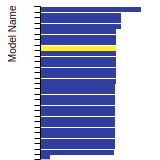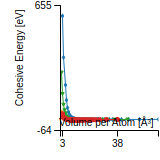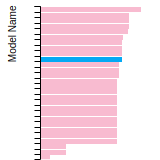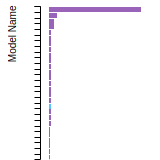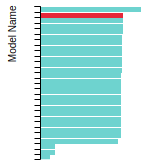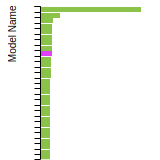 EAM_Dynamo_PunMishin_2012_Co__MO_885079680379_005
EAM_Dynamo_PunMishin_2012_Co__MO_885079680379_005
| Title
A single sentence description.
|
EAM potential (LAMMPS cubic hermite tabulation) for hcp and fcc Cobalt developed by Purja Pun and Mishin (2012) v005 |
|---|---|
| Description
A short description of the Model describing its key features including for example: type of model (pair potential, 3-body potential, EAM, etc.), modeled species (Ac, Ag, ..., Zr), intended purpose, origin, and so on.
|
We report on the development of an embedded-atom interatomic potential representing basic properties of both the hcp and the fcc phases of cobalt with nearly equal accuracy. The potential also reproduces the structural phase transformation between the two phases at a temperature close to the experimental value. The proposed potential can be used for large-scale atomistic simulations of cobalt microstructures over a wide range of temperatures. In a more general context, it offers a model for studying thermodynamic and kinetic properties of hcp/fcc interfaces and microstructure evolution in two-phase materials. |
| Species
The supported atomic species.
| Co |
| Disclaimer
A statement of applicability provided by the contributor, informing users of the intended use of this KIM Item.
|
The potential accurately represents most of the properties of the hcp and the fcc phases of Co including the phase transition temperature. |
| Content Origin | http://www.ctcms.nist.gov/potentials/Co.html |
| Contributor |
Ganga P. Purja Pun |
| Maintainer |
Ganga P. Purja Pun |
| Developer |
Yuri Mishin Ganga P. Purja Pun |
| Published on KIM | 2018 |
| How to Cite | Click here to download this citation in BibTeX format. |
| Citations
This panel presents information regarding the papers that have cited the interatomic potential (IP) whose page you are on. The OpenKIM machine learning based Deep Citation framework is used to determine whether the citing article actually used the IP in computations (denoted by "USED") or only provides it as a background citation (denoted by "NOT USED"). For more details on Deep Citation and how to work with this panel, click the documentation link at the top of the panel. The word cloud to the right is generated from the abstracts of IP principle source(s) (given below in "How to Cite") and the citing articles that were determined to have used the IP in order to provide users with a quick sense of the types of physical phenomena to which this IP is applied. The bar chart shows the number of articles that cited the IP per year. Each bar is divided into green (articles that USED the IP) and blue (articles that did NOT USE the IP). Users are encouraged to correct Deep Citation errors in determination by clicking the speech icon next to a citing article and providing updated information. This will be integrated into the next Deep Citation learning cycle, which occurs on a regular basis. OpenKIM acknowledges the support of the Allen Institute for AI through the Semantic Scholar project for providing citation information and full text of articles when available, which are used to train the Deep Citation ML algorithm. |
This panel provides information on past usage of this interatomic potential (IP) powered by the OpenKIM Deep Citation framework. The word cloud indicates typical applications of the potential. The bar chart shows citations per year of this IP (bars are divided into articles that used the IP (green) and those that did not (blue)). The complete list of articles that cited this IP is provided below along with the Deep Citation determination on usage. See the Deep Citation documentation for more information. 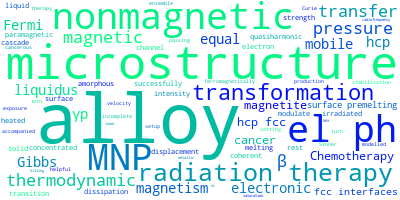
59 Citations (33 used)
Help us to determine which of the papers that cite this potential actually used it to perform calculations. If you know, click the .
USED (high confidence) I. Bryukhanov, V. Gorodtsov, and D. Lisovenko, “Modeling of the Mechanical Properties of Chiral Metallic Nanotubes,” Physical Mesomechanics. 2020. link Times cited: 9 USED (high confidence) A. A. Deshmukh and S. Pal, “Dynamic probing of structural evolution for Co50Ni50 metallic glass during pressurized cooling using atomistic simulation,” Journal of Molecular Modeling. 2020. link Times cited: 1 USED (high confidence) H. Sun, Z. Jian, J. Xu, B. Jiang, and C. Liu, “Rapid solidification of cobalt melt by molecular dynamics simulation,” Journal of Thermal Analysis and Calorimetry. 2019. link Times cited: 2 USED (high confidence) X. Liu, X. Wen, and R. Hoffmann, “Surface Activation of Transition Metal Nanoparticles for Heterogeneous Catalysis: What We Can Learn from Molecular Dynamics,” ACS Catalysis. 2018. link Times cited: 43 Abstract: Many heterogeneous reactions catalyzed by nanoparticles occu… read more USED (high confidence) J. Tranchida, S. Plimpton, P. Thibaudeau, and A. Thompson, “Massively parallel symplectic algorithm for coupled magnetic spin dynamics and molecular dynamics,” J. Comput. Phys. 2018. link Times cited: 76 USED (high confidence) A. Jokisaari, S. Naghavi, C. Wolverton, P. Voorhees, and O. Heinonen, “Predicting the morphologies of γ’ precipitates in cobalt-based superalloys,” arXiv: Materials Science. 2017. link Times cited: 61 USED (high confidence) C. Wang, C. Li, J. Han, L. Yan, B. Deng, and X. Liu, “The pressure-temperature phase diagram of pure Co based on first-principles calculations.,” Physical chemistry chemical physics : PCCP. 2017. link Times cited: 2 Abstract: We optimized the high pressure-temperature phase diagram of … read more USED (high confidence) L. Béland, Y. Osetsky, and R. Stoller, “Atomistic material behavior at extreme pressures.” 2016. link Times cited: 26 USED (high confidence) G. Samolyuk, L. Béland, G. M. Stocks, and R. Stoller, “Electron–phonon coupling in Ni-based binary alloys with application to displacement cascade modeling,” Journal of Physics: Condensed Matter. 2016. link Times cited: 36 Abstract: Energy transfer between lattice atoms and electrons is an im… read more USED (high confidence) S. Das, B. Javvaji, S. Veerla, and D. R. Mahapatra, “Magnetic nanoparticles for thermal lysis and application in cancer treatment,” SPIE BiOS. 2016. link Times cited: 0 Abstract: Chemotherapy and radiation-therapy are conventional treatmen… read more USED (low confidence) S. Risal et al., “Development of the RF-MEAM Interatomic Potential for the Fe-C System to Study the Temperature-Dependent Elastic Properties,” Materials. 2023. link Times cited: 0 Abstract: One of the major impediments to the computational investigat… read more USED (low confidence) C.-F. Zhang et al., “NaCl induced active hcp Co nanosheet for hydrogen production and formaldehyde abatement by formaldehyde steam reforming,” Chemical Engineering Journal. 2022. link Times cited: 7 USED (low confidence) Y.-chao Liang, R. Ma, L.-li Zhou, M. He, Z. Tian, and Y. Mo, “Microstructure Evolution of Ni-Co Alloys During Crystallization and Amorphization Process,” Journal of Superconductivity and Novel Magnetism. 2021. link Times cited: 0 USED (low confidence) R. Ma et al., “The effect of HCP on the formation of twin boundaries and dislocations in Ni–Co alloys,” Current Applied Physics. 2021. link Times cited: 2 USED (low confidence) R. Su et al., “High-strength nanocrystalline intermetallics with room temperature deformability enabled by nanometer thick grain boundaries,” Science Advances. 2021. link Times cited: 9 Abstract: Nanometer thick grain boundaries enable room temperature def… read more USED (low confidence) R. Su et al., “Ultra-high strength and plasticity mediated by partial dislocations and defect networks: Part II: Layer thickness effect,” Acta Materialia. 2021. link Times cited: 7 USED (low confidence) P. Wang, Y. Bu, J. Liu, Q. Li, H. Wang, and W. Yang, “Atomic deformation mechanism and interface toughening in metastable high entropy alloy,” Materials Today. 2020. link Times cited: 41 USED (low confidence) R. Su et al., “Ultra-high strength and plasticity mediated by partial dislocations and defect networks: Part I: Texture effect,” Acta Materialia. 2020. link Times cited: 19 USED (low confidence) A. Sobolev, O. Golovnia, and A. Popov, “Embedded atom potential for Sm–Co compounds obtained by force-matching,” Journal of Magnetism and Magnetic Materials. 2019. link Times cited: 3 USED (low confidence) X. Lu, P. Yang, J. Luo, J. Ren, H. Xue, and Y. Ding, “Tensile mechanical performance of Ni–Co alloy nanowires by molecular dynamics simulation,” RSC Advances. 2019. link Times cited: 17 Abstract: In this present contribution, tensile mechanical properties … read more USED (low confidence) D. Zhang and S. Chaudhuri, “Solidification dynamics and microstructure evolution in nanocrystalline cobalt,” Computational Materials Science. 2019. link Times cited: 8 USED (low confidence) R. Agrawal, P. Phatak, and L. Spanu, “Effect of phase and size on surface sites in cobalt nanoparticles,” Catalysis Today. 2018. link Times cited: 19 USED (low confidence) L. Béland et al., “Accurate classical short-range forces for the study of collision cascades in Fe-Ni-Cr,” Comput. Phys. Commun. 2017. link Times cited: 34 USED (low confidence) W. Wang, F. Yuan, P. Jiang, and X. Wu, “Size effects of lamellar twins on the strength and deformation mechanisms of nanocrystalline hcp cobalt,” Scientific Reports. 2017. link Times cited: 14 USED (low confidence) T. L. Achmad, W. Fu, H. Chen, C. Zhang, and Z.-G. Yang, “Effects of alloying elements concentrations and temperatures on the stacking fault energies of Co-based alloys by computational thermodynamic approach and first-principles calculations,” Journal of Alloys and Compounds. 2017. link Times cited: 45 USED (low confidence) Z. Wu and W. Curtin, “Mechanism and energetics of 〈c + a〉 dislocation cross-slip in hcp metals,” Proceedings of the National Academy of Sciences. 2016. link Times cited: 94 Abstract: Significance For all hexagonal close-packed (hcp) metals, th… read more USED (low confidence) K. Xiong, Y. Zhang, and J. Gu, “Deformation Twinning in Hexagonal Close-Packed Single Crystals under Uniaxial Compression,” Materials Science Forum. 2016. link Times cited: 0 Abstract: In this paper, the uniaxial compression of Mg, Ti, Zr and Co… read more USED (low confidence) L. Béland et al., “Features of primary damage by high energy displacement cascades in concentrated Ni-based alloys,” Journal of Applied Physics. 2016. link Times cited: 53 Abstract: Alloying of Ni with Fe or Co has been shown to reduce primar… read more USED (low confidence) K. Xiong, X. Liu, C. Li, and J. Gu, “Phonon instability of Co single crystal in uniaxial tension and nanoindentation,” Computational Materials Science. 2015. link Times cited: 8 USED (low confidence) W.-jin Zhang, Y. Peng, and Z.-L. Liu, “Molecular dynamics study of melting curve, entropy of fusion and solid-liquid interfacial energy of cobalt under pressure,” Physica B-condensed Matter. 2014. link Times cited: 10 USED (low confidence) C. Li, C. Ni, W. Zhou, X. Duan, and X. Jin, “Phase stability of Co nanowires prepared by electrodeposition via AAO templates,” Materials Letters. 2013. link Times cited: 8 USED (low confidence) P. Chowdhury and H. Sehitoglu, “Atomistic Fault Energetics and Critical Stress Prediction for fcc and bcc Twinning : Recent Progress AQ 3.” 2017. link Times cited: 10 Abstract: 15 This article recounts recent advances on the atomistic mo… read more USED (low confidence) S. Dmitriev, A. Kistanov, and V. Dubinko, “Moving Discrete Breathers in 2D and 3D Crystals.” 2015. link Times cited: 8 NOT USED (low confidence) S. Mukesh and N. Lanzillo, “A Multiscale Simulation Study of the Structural Integrity of Damascene Interconnects in Advanced Technology Nodes,” IEEE Transactions on Electron Devices. 2023. link Times cited: 0 Abstract: The structural stability of tight-pitched (18 nm and below) … read more NOT USED (low confidence) M. C. Kaymak, A. Rahnamoun, K. A. O’Hearn, A. V. van Duin, J. Kenneth M. Merz, and H. Aktulga, “JAX-ReaxFF: A Gradient Based Framework for Extremely Fast Optimization of Reactive Force Fields,” ChemRxiv. 2021. link Times cited: 1 Abstract: Molecular dynamics (MD) simulations facilitate the study of … read more NOT USED (low confidence) J. Tong et al., “Interfacial antiferromagnetic coupling and high spin polarization in metallic phthalocyanines,” Physical Review B. 2021. link Times cited: 3 Abstract: Exploration and understanding of the spinterface between mag… read more NOT USED (low confidence) J. Fürnkranz, “Publication list,” Journal of Physics: Conference Series. 2019. link Times cited: 10 Abstract: PUBLICATION LIST of VICTOR MANUEL VILLANUEVA SANDOVAL availa… read more NOT USED (high confidence) J. Qi, C. Oberdorfer, W. Windl, and E. Marquis, “Ab initio
simulation of field evaporation,” Physical Review Materials. 2022. link Times cited: 5 Abstract: A new simulation approach of field evaporation is presented.… read more NOT USED (high confidence) M. Gu, Y. Bai, G. Zhang, and T. George, “Spin–phonon dispersion in magnetic materials,” Journal of Physics: Condensed Matter. 2022. link Times cited: 2 Abstract: Microscopic coupling between the electron spin and the latti… read more NOT USED (high confidence) K. Kowalczyk-Gajewska and M. Ma’zdziarz, “Elastic properties of nanocrystalline materials of hexagonal symmetry: The core-shell model and atomistic estimates,” International Journal of Engineering Science. 2020. link Times cited: 5 NOT USED (high confidence) J. Martí and B. Díaz, “Efficient recursive Adams–Bashforth methods in molecular dynamics simulations of N-body systems interacting through pairwise potentials,” Molecular Simulation. 2020. link Times cited: 1 Abstract: ABSTRACT A recursive multistep Adams–Bashforth method applie… read more NOT USED (high confidence) M. Vallone, “Structural Phase Transitions in Crystals: Phonons as Higgs and Goldstone Excitations,” physica status solidi (RRL) – Rapid Research Letters. 2020. link Times cited: 0 Abstract: It has recently been indicated that optical and acoustic pho… read more NOT USED (high confidence) Y. M. Gufan, O. V. Naskalova, O. V. Kukin, and G. V. Fomin, “Symmetry Of Irreducible Cluster Energy And The Theory Of Elastic Constant Crystals: Co as an Example.” 2018. link Times cited: 0 Abstract: The paper proposes a new method of transferable calculation… read more NOT USED (high confidence) R. Khusnutdinoff, A. Mokshin, A. L. Bel’tyukov, and N. Olyanina, “Viscosity of Cobalt Melt: Experiment, Simulation, and Theory,” High Temperature. 2018. link Times cited: 5 NOT USED (high confidence) P. Chowdhury and H. Sehitoglu, “Atomistic Energetics and Critical Twinning Stress Prediction in Face and Body Centered Cubic Metals: Recent Progress,” Journal of Engineering Materials and Technology-transactions of The Asme. 2018. link Times cited: 19 Abstract: This paper recounts recent advances on the atomistic modelin… read more NOT USED (high confidence) W. Wang, P. Jiang, F. Yuan, and X. Wu, “Size effects of nano-spaced basal stacking faults on the strength and deformation mechanisms of nanocrystalline pure hcp metals,” Philosophical Magazine. 2018. link Times cited: 5 Abstract: The size effects of nano-spaced basal stacking faults (SFs) … read more NOT USED (high confidence) B. Cheng and M. Ceriotti, “Computing the absolute Gibbs free energy in atomistic simulations: Applications to defects in solids,” Physical Review B. 2017. link Times cited: 40 Abstract: The Gibbs free energy is the fundamental thermodynamic poten… read more NOT USED (high confidence) M. Mattheakis, M. Mattheakis, M. Mattheakis, G. Tsironis, G. Tsironis, and G. Tsironis, “Quodons in Mica: Nonlinear Localized Travelling Excitations in Crystals,” Quodons in Mica. 2017. link Times cited: 24 NOT USED (high confidence) Y. Wang et al., “Precursor-directed synthesis of porous cobalt assemblies with tunable close-packed hexagonal and face-centered cubic phases for the effective enhancement in microwave absorption,” Journal of Materials Science. 2017. link Times cited: 30 NOT USED (high confidence) B. Molaei and S. A. Kahani, “Synthesis of cobalt-based magnetic nanocrystals from cobalt(II) heterocyclic amine complexes,” Research on Chemical Intermediates. 2017. link Times cited: 0 NOT USED (high confidence) R. Babicheva et al., “Elastic moduli of nanocrystalline binary Al alloys with Fe, Co, Ti, Mg and Pb alloying elements,” Philosophical Magazine. 2016. link Times cited: 13 Abstract: The paper studies the elastic moduli of nanocrystalline (NC)… read more NOT USED (high confidence) P. Chowdhury, H. Sehitoglu, H. Maier, and R. Rateick, “Strength prediction in NiCo alloys - The role of composition and nanotwins,” International Journal of Plasticity. 2016. link Times cited: 58 NOT USED (high confidence) V. Yamakov et al., “Multiscale modeling of sensory properties of Co–Ni–Al shape memory particles embedded in an Al metal matrix,” Journal of Materials Science. 2016. link Times cited: 24 NOT USED (high confidence) K. Zhang, M. Fan, Y. Liu, J. Schroers, M. Shattuck, and C. O’Hern, “Beyond packing of hard spheres: The effects of core softness, non-additivity, intermediate-range repulsion, and many-body interactions on the glass-forming ability of bulk metallic glasses.,” The Journal of chemical physics. 2015. link Times cited: 16 Abstract: When a liquid is cooled well below its melting temperature a… read more NOT USED (high confidence) G. P. P. Pun, V. Yamakov, and Y. Mishin, “Interatomic potential for the ternary Ni–Al–Co system and application to atomistic modeling of the B2–L10 martensitic transformation,” Modelling and Simulation in Materials Science and Engineering. 2015. link Times cited: 80 Abstract: Ni–Al–Co is a promising system for ferromagnetic shape memor… read more NOT USED (high confidence) S. Schonecker, X. Li, K. Koepernik, B. Johansson, L. Vitos, and M. Richter, “Metastable cubic and tetragonal phases of transition metals predicted by density-functional theory,” RSC Advances. 2015. link Times cited: 9 Abstract: By means of density-functional calculations, we systematical… read more NOT USED (high confidence) H. Yoon et al., “In situ non-aqueous nucleation and growth of next generation rare-earth-free permanent magnets.,” Physical chemistry chemical physics : PCCP. 2015. link Times cited: 23 Abstract: Using a controllable wet chemical approach, the polyol proce… read more NOT USED (high confidence) D. Geissler, J. Freudenberger, A. Kauffmann, S. Martin, and D. Rafaja, “Assessment of the thermodynamic dimension of the stacking fault energy,” Philosophical Magazine. 2014. link Times cited: 21 Abstract: Especially with respect to high Mn and other austenitic TRan… read more NOT USED (high confidence) S. Meher, P. Nandwana, T. Rojhirunsakool, J. Tiley, and R. Banerjee, “Probing the crystallography of ordered Phases by coupling of orientation microscopy with atom probe tomography.,” Ultramicroscopy. 2015. link Times cited: 17 |
| Funding | Not available |
| Short KIM ID
The unique KIM identifier code.
| MO_885079680379_005 |
| Extended KIM ID
The long form of the KIM ID including a human readable prefix (100 characters max), two underscores, and the Short KIM ID. Extended KIM IDs can only contain alpha-numeric characters (letters and digits) and underscores and must begin with a letter.
| EAM_Dynamo_PunMishin_2012_Co__MO_885079680379_005 |
| DOI |
10.25950/8d5b6ade https://doi.org/10.25950/8d5b6ade https://commons.datacite.org/doi.org/10.25950/8d5b6ade |
| KIM Item Type
Specifies whether this is a Portable Model (software implementation of an interatomic model); Portable Model with parameter file (parameter file to be read in by a Model Driver); Model Driver (software implementation of an interatomic model that reads in parameters).
| Portable Model using Model Driver EAM_Dynamo__MD_120291908751_005 |
| Driver | EAM_Dynamo__MD_120291908751_005 |
| KIM API Version | 2.0 |
| Potential Type | eam |
| Previous Version | EAM_Dynamo_PunMishin_2012_Co__MO_885079680379_004 |
| Grade | Name | Category | Brief Description | Full Results | Aux File(s) |
|---|---|---|---|---|---|
| P | vc-species-supported-as-stated | mandatory | The model supports all species it claims to support; see full description. |
Results | Files |
| P | vc-periodicity-support | mandatory | Periodic boundary conditions are handled correctly; see full description. |
Results | Files |
| P | vc-permutation-symmetry | mandatory | Total energy and forces are unchanged when swapping atoms of the same species; see full description. |
Results | Files |
| A | vc-forces-numerical-derivative | consistency | Forces computed by the model agree with numerical derivatives of the energy; see full description. |
Results | Files |
| F | vc-dimer-continuity-c1 | informational | The energy versus separation relation of a pair of atoms is C1 continuous (i.e. the function and its first derivative are continuous); see full description. |
Results | Files |
| P | vc-objectivity | informational | Total energy is unchanged and forces transform correctly under rigid-body translation and rotation; see full description. |
Results | Files |
| P | vc-inversion-symmetry | informational | Total energy is unchanged and forces change sign when inverting a configuration through the origin; see full description. |
Results | Files |
| P | vc-memory-leak | informational | The model code does not have memory leaks (i.e. it releases all allocated memory at the end); see full description. |
Results | Files |
| P | vc-thread-safe | mandatory | The model returns the same energy and forces when computed in serial and when using parallel threads for a set of configurations. Note that this is not a guarantee of thread safety; see full description. |
Results | Files |
| P | vc-unit-conversion | mandatory | The model is able to correctly convert its energy and/or forces to different unit sets; see full description. |
Results | Files |
BCC Lattice Constant
This bar chart plot shows the mono-atomic body-centered cubic (bcc) lattice constant predicted by the current model (shown in the unique color) compared with the predictions for all other models in the OpenKIM Repository that support the species. The vertical bars show the average and standard deviation (one sigma) bounds for all model predictions. Graphs are generated for each species supported by the model.
Cohesive Energy Graph
This graph shows the cohesive energy versus volume-per-atom for the current mode for four mono-atomic cubic phases (body-centered cubic (bcc), face-centered cubic (fcc), simple cubic (sc), and diamond). The curve with the lowest minimum is the ground state of the crystal if stable. (The crystal structure is enforced in these calculations, so the phase may not be stable.) Graphs are generated for each species supported by the model.
Diamond Lattice Constant
This bar chart plot shows the mono-atomic face-centered diamond lattice constant predicted by the current model (shown in the unique color) compared with the predictions for all other models in the OpenKIM Repository that support the species. The vertical bars show the average and standard deviation (one sigma) bounds for all model predictions. Graphs are generated for each species supported by the model.
Dislocation Core Energies
This graph shows the dislocation core energy of a cubic crystal at zero temperature and pressure for a specific set of dislocation core cutoff radii. After obtaining the total energy of the system from conjugate gradient minimizations, non-singular, isotropic and anisotropic elasticity are applied to obtain the dislocation core energy for each of these supercells with different dipole distances. Graphs are generated for each species supported by the model.
(No matching species)FCC Elastic Constants
This bar chart plot shows the mono-atomic face-centered cubic (fcc) elastic constants predicted by the current model (shown in blue) compared with the predictions for all other models in the OpenKIM Repository that support the species. The vertical bars show the average and standard deviation (one sigma) bounds for all model predictions. Graphs are generated for each species supported by the model.
FCC Lattice Constant
This bar chart plot shows the mono-atomic face-centered cubic (fcc) lattice constant predicted by the current model (shown in red) compared with the predictions for all other models in the OpenKIM Repository that support the species. The vertical bars show the average and standard deviation (one sigma) bounds for all model predictions. Graphs are generated for each species supported by the model.
FCC Stacking Fault Energies
This bar chart plot shows the intrinsic and extrinsic stacking fault energies as well as the unstable stacking and unstable twinning energies for face-centered cubic (fcc) predicted by the current model (shown in blue) compared with the predictions for all other models in the OpenKIM Repository that support the species. The vertical bars show the average and standard deviation (one sigma) bounds for all model predictions. Graphs are generated for each species supported by the model.
(No matching species)FCC Surface Energies
This bar chart plot shows the mono-atomic face-centered cubic (fcc) relaxed surface energies predicted by the current model (shown in blue) compared with the predictions for all other models in the OpenKIM Repository that support the species. The vertical bars show the average and standard deviation (one sigma) bounds for all model predictions. Graphs are generated for each species supported by the model.
(No matching species)SC Lattice Constant
This bar chart plot shows the mono-atomic simple cubic (sc) lattice constant predicted by the current model (shown in the unique color) compared with the predictions for all other models in the OpenKIM Repository that support the species. The vertical bars show the average and standard deviation (one sigma) bounds for all model predictions. Graphs are generated for each species supported by the model.
Cubic Crystal Basic Properties Table
Species: CoDisclaimer From Model Developer
The potential accurately represents most of the properties of the hcp and the fcc phases of Co including the phase transition temperature.
Creators:
Contributor: karls
Publication Year: 2019
DOI: https://doi.org/10.25950/64cb38c5
This Test Driver uses LAMMPS to compute the cohesive energy of a given monoatomic cubic lattice (fcc, bcc, sc, or diamond) at a variety of lattice spacings. The lattice spacings range from a_min (=a_min_frac*a_0) to a_max (=a_max_frac*a_0) where a_0, a_min_frac, and a_max_frac are read from stdin (a_0 is typically approximately equal to the equilibrium lattice constant). The precise scaling and number of lattice spacings sampled between a_min and a_0 (a_0 and a_max) is specified by two additional parameters passed from stdin: N_lower and samplespacing_lower (N_upper and samplespacing_upper). Please see README.txt for further details.
| Test | Test Results | Link to Test Results page | Benchmark time
Usertime multiplied by the Whetstone Benchmark. This number can be used (approximately) to compare the performance of different models independently of the architecture on which the test was run.
Measured in Millions of Whetstone Instructions (MWI) |
|---|---|---|---|
| Cohesive energy versus lattice constant curve for bcc Co v004 | view | 9318 | |
| Cohesive energy versus lattice constant curve for diamond Co v004 | view | 7798 | |
| Cohesive energy versus lattice constant curve for fcc Co v004 | view | 8393 | |
| Cohesive energy versus lattice constant curve for sc Co v004 | view | 8393 |
Creators: Junhao Li and Ellad Tadmor
Contributor: tadmor
Publication Year: 2019
DOI: https://doi.org/10.25950/5853fb8f
Computes the cubic elastic constants for some common crystal types (fcc, bcc, sc, diamond) by calculating the hessian of the energy density with respect to strain. An estimate of the error associated with the numerical differentiation performed is reported.
| Test | Test Results | Link to Test Results page | Benchmark time
Usertime multiplied by the Whetstone Benchmark. This number can be used (approximately) to compare the performance of different models independently of the architecture on which the test was run.
Measured in Millions of Whetstone Instructions (MWI) |
|---|---|---|---|
| Elastic constants for bcc Co at zero temperature v006 | view | 6238 | |
| Elastic constants for diamond Co at zero temperature v001 | view | 11356 | |
| Elastic constants for fcc Co at zero temperature v006 | view | 4031 | |
| Elastic constants for sc Co at zero temperature v006 | view | 2207 |
Creators: Junhao Li
Contributor: jl2922
Publication Year: 2019
DOI: https://doi.org/10.25950/d794c746
Computes the elastic constants for hcp crystals by calculating the hessian of the energy density with respect to strain. An estimate of the error associated with the numerical differentiation performed is reported.
| Test | Test Results | Link to Test Results page | Benchmark time
Usertime multiplied by the Whetstone Benchmark. This number can be used (approximately) to compare the performance of different models independently of the architecture on which the test was run.
Measured in Millions of Whetstone Instructions (MWI) |
|---|---|---|---|
| Elastic constants for hcp Co at zero temperature v004 | view | 2069 |
Creators:
Contributor: ilia
Publication Year: 2024
DOI: https://doi.org/10.25950/2f2c4ad3
Computes the equilibrium crystal structure and energy for an arbitrary crystal at zero temperature and applied stress by performing symmetry-constrained relaxation. The crystal structure is specified using the AFLOW prototype designation. Multiple sets of free parameters corresponding to the crystal prototype may be specified as initial guesses for structure optimization. No guarantee is made regarding the stability of computed equilibria, nor that any are the ground state.
| Test | Test Results | Link to Test Results page | Benchmark time
Usertime multiplied by the Whetstone Benchmark. This number can be used (approximately) to compare the performance of different models independently of the architecture on which the test was run.
Measured in Millions of Whetstone Instructions (MWI) |
|---|---|---|---|
| Equilibrium crystal structure and energy for Co in AFLOW crystal prototype A_cF4_225_a v002 | view | 93056 | |
| Equilibrium crystal structure and energy for Co in AFLOW crystal prototype A_hP2_194_c v002 | view | 73989 | |
| Equilibrium crystal structure and energy for Co in AFLOW crystal prototype A_tI2_139_a v002 | view | 46299 | |
| Equilibrium crystal structure and energy for Co in AFLOW crystal prototype A_tP28_136_f2ij v002 | view | 147683 |
Creators: Daniel S. Karls and Junhao Li
Contributor: karls
Publication Year: 2019
DOI: https://doi.org/10.25950/2765e3bf
Equilibrium lattice constant and cohesive energy of a cubic lattice at zero temperature and pressure.
| Test | Test Results | Link to Test Results page | Benchmark time
Usertime multiplied by the Whetstone Benchmark. This number can be used (approximately) to compare the performance of different models independently of the architecture on which the test was run.
Measured in Millions of Whetstone Instructions (MWI) |
|---|---|---|---|
| Equilibrium zero-temperature lattice constant for bcc Co v007 | view | 1855 | |
| Equilibrium zero-temperature lattice constant for diamond Co v007 | view | 3679 | |
| Equilibrium zero-temperature lattice constant for fcc Co v007 | view | 3775 | |
| Equilibrium zero-temperature lattice constant for sc Co v007 | view | 2495 |
Creators: Daniel S. Karls and Junhao Li
Contributor: karls
Publication Year: 2019
DOI: https://doi.org/10.25950/c339ca32
Calculates lattice constant of hexagonal bulk structures at zero temperature and pressure by using simplex minimization to minimize the potential energy.
| Test | Test Results | Link to Test Results page | Benchmark time
Usertime multiplied by the Whetstone Benchmark. This number can be used (approximately) to compare the performance of different models independently of the architecture on which the test was run.
Measured in Millions of Whetstone Instructions (MWI) |
|---|---|---|---|
| Equilibrium lattice constants for hcp Co v005 | view | 28493 |
Creators:
Contributor: efuem
Publication Year: 2023
DOI: https://doi.org/10.25950/fca89cea
Computes the monovacancy formation energy and relaxation volume for cubic and hcp monoatomic crystals.
| Test | Test Results | Link to Test Results page | Benchmark time
Usertime multiplied by the Whetstone Benchmark. This number can be used (approximately) to compare the performance of different models independently of the architecture on which the test was run.
Measured in Millions of Whetstone Instructions (MWI) |
|---|---|---|---|
| Monovacancy formation energy and relaxation volume for hcp Co | view | 439662 |
Creators:
Contributor: efuem
Publication Year: 2023
DOI: https://doi.org/10.25950/c27ba3cd
Computes the monovacancy formation and migration energies for cubic and hcp monoatomic crystals.
| Test | Test Results | Link to Test Results page | Benchmark time
Usertime multiplied by the Whetstone Benchmark. This number can be used (approximately) to compare the performance of different models independently of the architecture on which the test was run.
Measured in Millions of Whetstone Instructions (MWI) |
|---|---|---|---|
| Vacancy formation and migration energy for hcp Co | view | 2903151 |
| Test | Error Categories | Link to Error page |
|---|---|---|
| Equilibrium crystal structure and energy for Co in AFLOW crystal prototype A_tP28_136_f2ij v000 | other | view |
EquilibriumCrystalStructure__TD_457028483760_002
| Test | Error Categories | Link to Error page |
|---|---|---|
| Equilibrium crystal structure and energy for Co in AFLOW crystal prototype A_oC4_63_c v002 | other | view |
LatticeConstantCubicEnergy__TD_475411767977_006
| Test | Error Categories | Link to Error page |
|---|---|---|
| Equilibrium zero-temperature lattice constant for diamond Co | other | view |
| EAM_Dynamo_PunMishin_2012_Co__MO_885079680379_005.txz | Tar+XZ | Linux and OS X archive |
| EAM_Dynamo_PunMishin_2012_Co__MO_885079680379_005.zip | Zip | Windows archive |
This Model requires a Model Driver. Archives for the Model Driver EAM_Dynamo__MD_120291908751_005 appear below.
| EAM_Dynamo__MD_120291908751_005.txz | Tar+XZ | Linux and OS X archive |
| EAM_Dynamo__MD_120291908751_005.zip | Zip | Windows archive |
